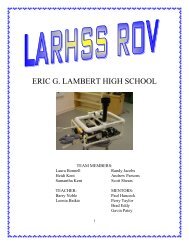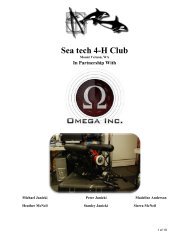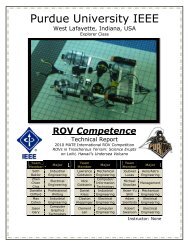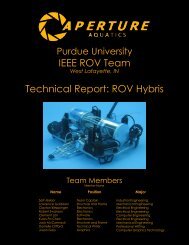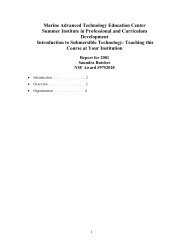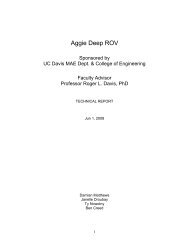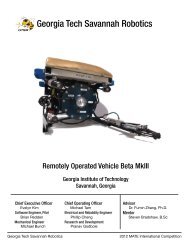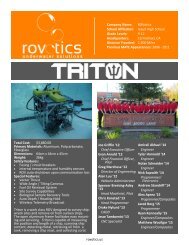Underwater Robotics: - the Marine Advanced Technology Education ...
Underwater Robotics: - the Marine Advanced Technology Education ...
Underwater Robotics: - the Marine Advanced Technology Education ...
You also want an ePaper? Increase the reach of your titles
YUMPU automatically turns print PDFs into web optimized ePapers that Google loves.
“This is <strong>the</strong> text and reference book that underwater<br />
robotics educators have been waiting for.”<br />
Drew Michel, <strong>Marine</strong> <strong>Technology</strong> Society ROV Committee Chair<br />
<strong>Underwater</strong> <strong>Robotics</strong>:<br />
Science, Design & Fabrication<br />
Introduces students, educators, and o<strong>the</strong>r aspiring inventors to subsea technology. This<br />
incredible resource provides <strong>the</strong> information needed to design and build underwater vehicles and<br />
showcases <strong>the</strong> many exciting careers available in ocean science, technology, and engineering.<br />
“This book<br />
will become an<br />
instant classic!”<br />
Marty Klein,<br />
side scan sonar pioneer
<strong>Underwater</strong> <strong>Robotics</strong>:<br />
Science, Design & Fabrication<br />
• Chapters 1-2 provide an introductory overview of<br />
manned and unmanned underwater craft (from earliest<br />
times to modern day) and suggests pragmatic strategies<br />
for designing underwater robots (particularly ROVs).<br />
• Chapters 3-10 introduce <strong>the</strong> limitations and challenges<br />
of working in water <strong>the</strong>n focus on specific technical<br />
issues, ranging from structure and materials to power<br />
systems and payloads. In each of <strong>the</strong>se topics, <strong>the</strong><br />
relevant science is paired with practical robotics. The<br />
chapters are filled with visual and textual examples,<br />
ranging from basic home-built vehicles to complex,<br />
commercial craft.<br />
• Chapter 11 and 12 move from <strong>the</strong>ory into hands-on<br />
learning. Chapter 11 details how to prepare and carry<br />
out missions, particularly those conducted by smaller<br />
ROVs. Chapter 12 provides complete plans and instruc-<br />
tions for a build-as-you-learn ROV <strong>the</strong>n discusses ideas<br />
and strategies for more advanced projects.<br />
CHAPTER 1: <strong>Underwater</strong> Vehicles<br />
CHAPTER 2: Design Toolkit<br />
CHAPTER 3: Working in Water<br />
CHAPTER 4: Structure and Materials<br />
CHAPTER 5: Pressure Hulls and<br />
Canisters<br />
CHAPTER 6: Buoyancy, Stability,<br />
and Ballast<br />
CHAPTER 7: Moving and Maneuvering<br />
CHAPTER 8: Power Systems<br />
CHAPTER 9: Navigation and Control<br />
CHAPTER 10: Payloads<br />
CHAPTER 11: Operations<br />
CHAPTER 12: SeaMATE<br />
Dr. Steven W. Moore, Harry Bohm, and Vickie Jensen<br />
This textbook is written for advanced high school classes, college and university entry-level courses, and <strong>the</strong><br />
underwater technology enthusiast. Each chapter begins with a true scenario that sets <strong>the</strong> stage for <strong>the</strong> ocean<br />
science, physics, math, electronics, and engineering concepts that follow. The final chapter features step-by-<br />
step plans for building SeaMATE, a basic shallow-diving ROV. There is also a “What’s Next?” section that’s full<br />
of ideas for modifications and more complex underwater projects.<br />
The 770-page informative text is enhanced by hundreds of photos, illustrations, and diagrams of underwater<br />
vehicles. In addition, <strong>the</strong> textbook includes a discussion of subsea vehicle development, resource appendices,<br />
an extensive glossary, and a complete index.<br />
WHAT’S INSIDE?<br />
Textual Aids and Information<br />
• All chapters include an outline, learning outcomes, and<br />
summary. Each chapter is introduced by a real-life scenario<br />
(called Stories From Real Life) that relates <strong>the</strong> basic <strong>the</strong>oretical<br />
information of that chapter to an actual subsea event.<br />
• There are over 500 photographs and illustrations throughout<br />
this book. The wealth of color photographs helps readers<br />
connect with actual examples of subsea robotics. The<br />
straight-forward illustrations are designed to expand and<br />
explain textual concepts.<br />
• Measurements are given in metric units, generally with<br />
imperial equivalents.<br />
• The emboldened terms in <strong>the</strong> text are defined in <strong>the</strong> glossary.<br />
• An index helps locate terms.<br />
• The appendices provide helpful tables of information, useful<br />
facts, equations, and suggestions for finding materials and<br />
resources.<br />
WHEN AND WHERE CAN WE GET IT?<br />
UNDERWATER ROBOTICS: Science, Design & Fabrication<br />
• ISBN 978-0-9841737-0-9<br />
is available NOW!<br />
• Retail cost: $99.95 per book with a 10% discount for schools.<br />
Shipping is extra.<br />
• No preview copies are available, but sample chapter pages are<br />
located at www.marinetech.org/underwater_robotics<br />
• To order, contact <strong>the</strong> MATE Center at info@marinetech.org<br />
or (831) 645-1393. An order form is also available at<br />
www.marinetech.org/underwater_robotics



